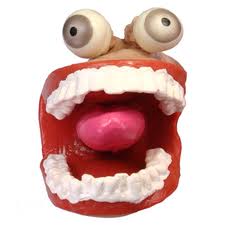The Golgi complex completes posttranslational modifications and packages and places an address on products that have been synthesized by the cell. This organelle is composed of smooth membrane-limited cisternae (Figures 2–21, 2–22, and 2–23). In highly polarized cells, such as mucus-secreting goblet cells (Figure 4–31), the Golgi complex occupies a characteristic position in the cytoplasm between the nucleus and the apical plasma membrane.
Figure 2-21
 Three-dimensional representation of a Golgi complex. Through transport vesicles that fuse with the Golgi cis face, the complex receives several types of molecules produced in the rough endoplasmic reticulum (RER). After Golgi processing, these molecules are released from the Golgi trans face in larger vesicles to constitute secretory vesicles, lysosomes, or other cytoplasmic components.
Three-dimensional representation of a Golgi complex. Through transport vesicles that fuse with the Golgi cis face, the complex receives several types of molecules produced in the rough endoplasmic reticulum (RER). After Golgi processing, these molecules are released from the Golgi trans face in larger vesicles to constitute secretory vesicles, lysosomes, or other cytoplasmic components.Figure 2-22
 Electron micrograph of a Golgi complex of a mucous cell. To the right is a cisterna (arrow) of the rough endoplasmic reticulum containing granular material. Close to it are small vesicles containing this material. This is the cis face of the complex. In the center are flattened and stacked cisternae of the Golgi complex. Dilatations can be observed extending from the ends of the cisternae. These dilatations gradually detach themselves from the cisternae and fuse, forming the secretory granules (1, 2, and 3). This is the trans face. Near the plasma membrane of two neighboring cells is endoplasmic reticulum with a smooth section (SER) and a rough section (RER). x30,000. Inset: The Golgi complex as seen in 1-m sections of epididymis cells impregnated with silver. x1200.
Electron micrograph of a Golgi complex of a mucous cell. To the right is a cisterna (arrow) of the rough endoplasmic reticulum containing granular material. Close to it are small vesicles containing this material. This is the cis face of the complex. In the center are flattened and stacked cisternae of the Golgi complex. Dilatations can be observed extending from the ends of the cisternae. These dilatations gradually detach themselves from the cisternae and fuse, forming the secretory granules (1, 2, and 3). This is the trans face. Near the plasma membrane of two neighboring cells is endoplasmic reticulum with a smooth section (SER) and a rough section (RER). x30,000. Inset: The Golgi complex as seen in 1-m sections of epididymis cells impregnated with silver. x1200.Figure 2-23
Main events occurring during trafficking and sorting of proteins through the Golgi complex. Numbered at the left are the main molecular processes that take place in the compartments indicated. Note that the labeling of lysosomal enzymes starts early in the cis Golgi network. In the trans Golgi network, the glycoproteins combine with specific receptors that guide them to their destination. On the left side of the drawing is the returning flux of membrane, from the Golgi to the endoplasmic reticulum. (Redrawn and reproduced, with permission, from Junqueira LC, Carneiro J: Biologia Celular e Molecular, 6th ed. Editora Guanabara, 1997.)
In most cells, there is also polarity in Golgi structure and function. Near the Golgi complex, the RER can sometimes be seen budding off small vesicles (transport vesicles) that shuttle newly synthesized proteins to the Golgi complex for further processing. The Golgi cisterna nearest this point is called the forming, convex, or cis face. On the opposite side of the Golgi complex, which is the maturing, concave, or trans face, large Golgi vacuoles accumulate (Figure 2–21). These are sometimes called condensing vacuoles.
These structures bud from the Golgi cisternae, generating vesicles that will transport proteins to various sites. Cytochemical methods and the electron microscope have shown that the Golgi cisternae present different enzymes at different cis–trans levels and that the Golgi complex is important in the glycosylation, sulfating, phosphorylation, and limited proteolysis of proteins. Furthermore, the Golgi complex initiates packing, concentration, and storage of secretory products. Figure 2–23 provides an overall view of the currently accepted concepts regarding transit of material through the Golgi complex.
| References
|


















3 comments:
Nice post, things explained in details. Thank You.
Blogging is the new poetry. I find it wonderful and amazing in many ways.
That is an extremely smartly written article. I will be sure to bookmark it and return to learn extra of your useful information. Thank you for the post. I will certainly return.
Posting Komentar